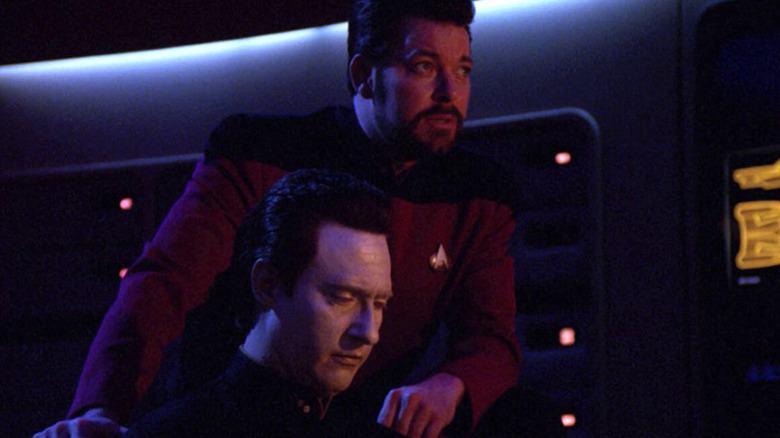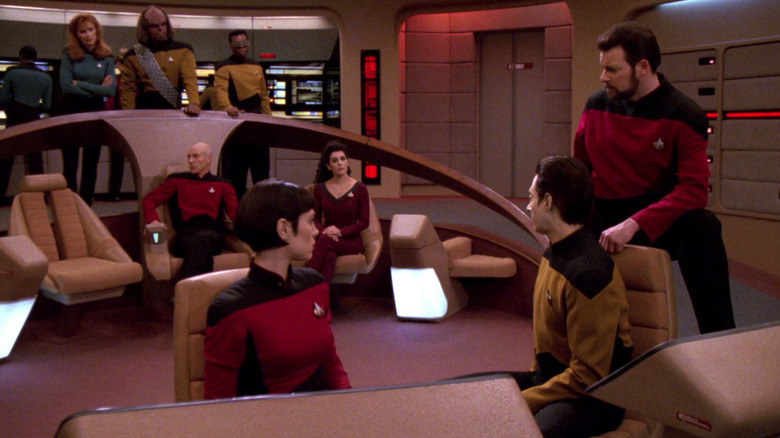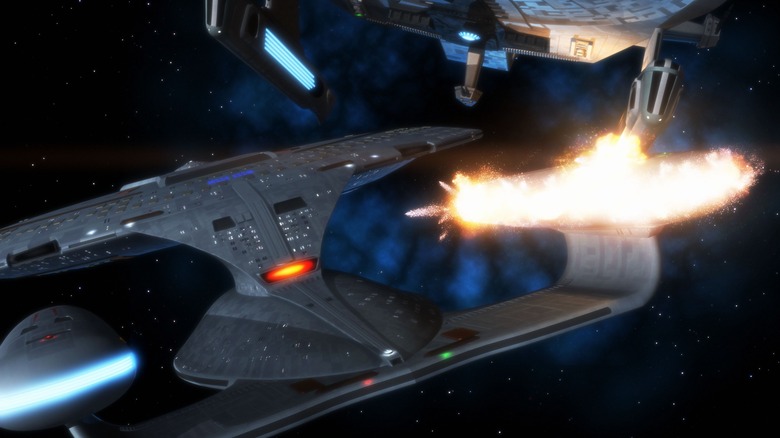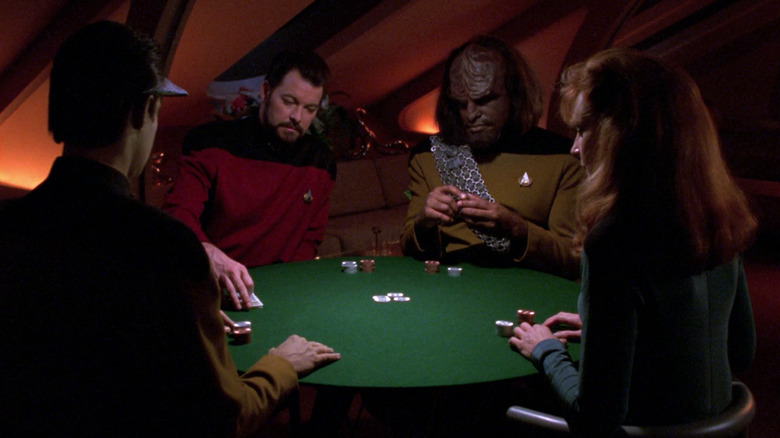An Outside-The-Box Star Trek Script Put Jonathan Frakes' Directing To The Test
Jonathan Frakes, who played Commander William Riker on "Star Trek: The Next Generation" began directing episodes of the show starting in its third season, beginning with the March 1990 episode "The Offspring." Frakes would remain a directorial staple throughout Trek, going on to direct seven additional "Next Gen" episodes, two of its movies ("First Contact" and "Insurrection"), three episode of "Deep Space Nine," three episodes of "Voyager," seven episodes of "Discovery" and four more of "Picard." Also Frakes directed two episodes of "The Orville," which kind of counts. And that's just Trek. This is nothing to speak of Frakes' work on any of the other myriad shows he has directed — nor of his feature films "Clockstoppers" and "Thunderbirds."
The fourth "Next Gen" episode that Frakes helmed was called "Cause and Effect" (March 23, 1992), a clever episode written by longtime Trek writer Brannon Braga about the Enterprise becoming caught in a repeating time loop. Every act of the show would begin with the same opening shot of the Enterprise soaring idly on its mission, and the end of every act would see the Enterprise being destroyed by colliding with another ship that appears unexpectedly out of a mysterious space hole. After the explosion, the timeline would reset, and the Enterprise crew would have to live through the same events again. Only a very vague sense of déjà vu indicated to the crew that they had lived through something before. Eventually, the crew learns just enough through repeated, weird premonitions to start sending very simple information into the next time loop.
Cause and Effect
A repeating time loop story would be a difficult challenge for any director, as one would want to repeat some visuals — to maintain the continuity of a story repeated — but offer up slightly different takes or angles here and there to indicate that something has indeed changed; visual variety should be maintained. Given the limitations of the story, however, Frakes — in a retrospective in the Hollywood Reporter — expressed frustration in the types number of shots that he could film. Indeed, initially, Frakes didn't quite understand what Braga was trying to do, going so far as to feel that the writer was having him on.
"At first," Frakes said, "I didn't really get that what Brannon was trying to do was a different kind of 'Rashomon' story. It was an evolution almost of the way [the characters] understand what was going on." Frakes, in trying to capture an evolving narrative within the confines of repeating shots, described the experience as an "advanced director's test."
Frakes' mention of "Rashomon" was a reference to the 1950 Akira Kurosawa film (named after a 1915 short story, in turn named after a 1420 Noh play) about a murder in the woods, and several eyewitness reports that all conflict wildly, with each character claiming to have committed the murder.
With evolving perspectives, Frakes moved forward cautiously, often stymied by what the show had done. A long-running TV program has the same crew and cast every week, and an established look and tone was already locked in place. What creativity can an individual director bring to such a firmly based universe? As it turns out, Frakes had some creative wiggle room.
Was Braga ****ing with me?
Just like filming a car commercial, there are only so many places one can fit a camera on the set of "Star Trek: The Next Generation." Frakes thought of differing ways he could shoot establishing shots, and gives a lot of credit to the episode's editor for any level of cohesion that "Cause and Effect" possessed.
"There are only so many shots you can do. So, stylistically, we tried different things for different scenes — and J.P. Farrell, who cut the episode — deserves a lot of the credit for making those sequences work. We had a plan that we needed to shoot each scene more than one way; We would shoot the master from either side of the room. But I really enjoyed the challenge. Once I realized that [Braga] wasn't f***ing with me, it was fun."
Frakes also learned the truth of the old adage that necessity is the mother of invention. "Cause and Effect" required several scenes wherein the Enterprise crew would meet on the ship's observation lounge, the place where the senior staff would discuss potential solutions to the week's crisis. The room contains only a large table, some office chairs, a few decorative models on the walls, a ficus plant, and a TV screen. With plain furniture in an oft-filmed room, Frakes found a new shot.
"I think during prep, I was with Doug Dean, he was my first [A.D.], and we're shooting one of the many scenes in the conference room, the observation lounge set. And we got an overhead shot of the conference room that we hadn't used before. I said: 'What if we go all the way up there?' And [Doug] said: 'Well, nobody's gone there.' To which I was like: 'Oh, all the better!'"
Borrowing from Spielberg
Another recurring element of "Cause and Effect" are the moments when each character experiences déjà vu — or, as the Klingon Worf (Michael Dorn) calls it: nIb'poH — to clue them into the fact that time is repeating itself. Braga did write certain moments of description into the teleplay — Worf describes his feeling during a poker game — but it would be up to Frakes to visually indicate when each of the other characters had a subtle moment of realization. Frakes found interesting new ways to move the camera to communicate these moments. He told THR:
"We did a lot of those Spielberg-style push-ins and close-ups. We started with Crusher figuring it out first, then Dorn as he figures it out during a poker game. And then Picard (Patrick Stewart), later in a scene, we push in on him reading a book as he realizes he's read that section before. So there were enough kind of signature, visual metaphors for [the characters] figuring it out and agreeing on what was going on."
"Cause and Effect" is one of the cleverer episodes of "Next Generation," and while Braga had some trouble getting his ideas accepted by the show's executive producers Rick Berman and Michael Piller (Braga, in the retrospective, recalls people asking, "Is this a joke?"), and while Frakes faced down some creative directorial challenges, the episode emerged as creative and memorable.
The cherry on top was, once the Enterprise broke out of the time loop — as they naturally must — Picard was able to have a conversation with the other ship, helmed by Captain Bateson (Kelsey Grammer in a cameo role). He had been stuck in the same time loop for upwards of 90 years.
Captain Bateson, welcome to the 24th century.



